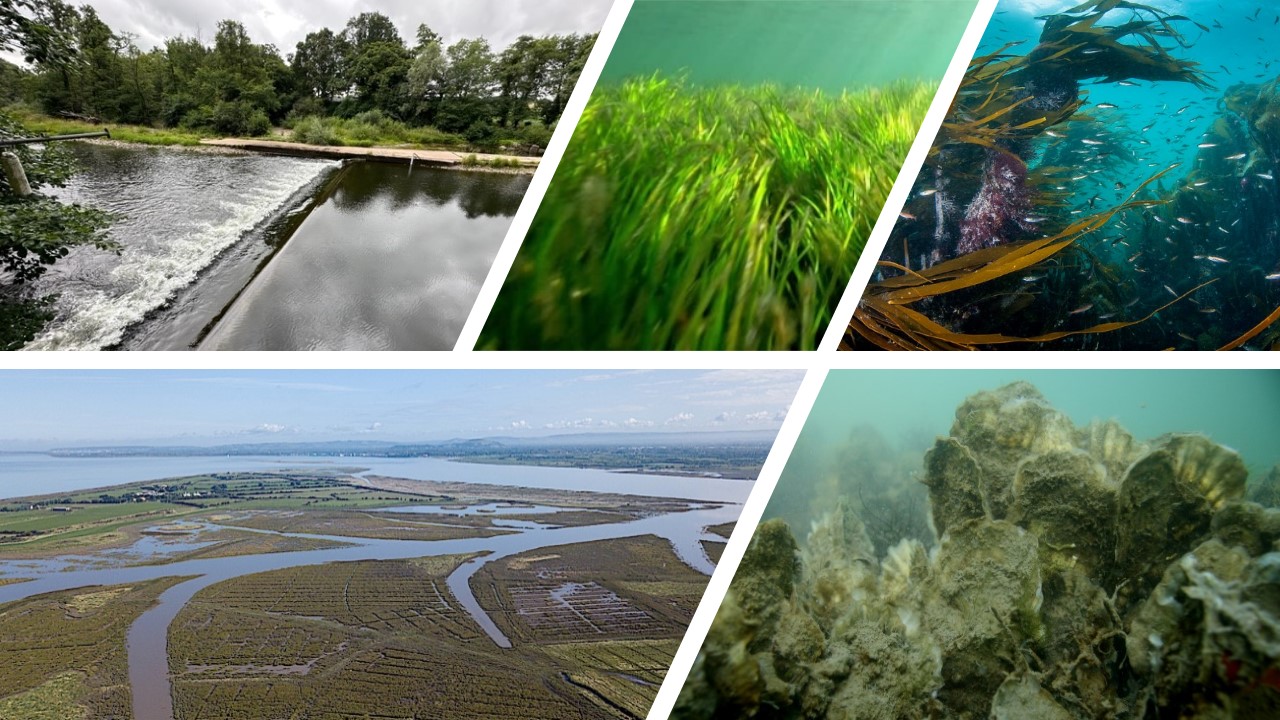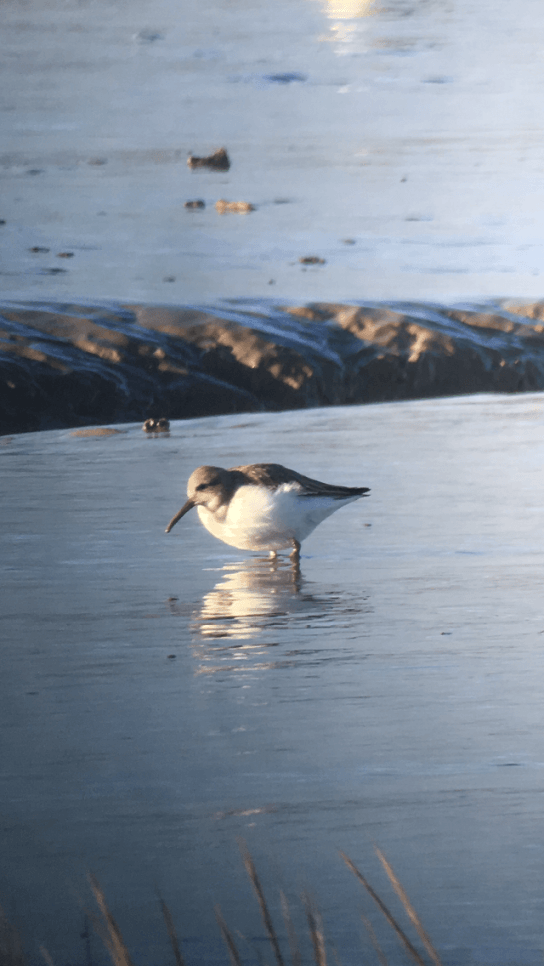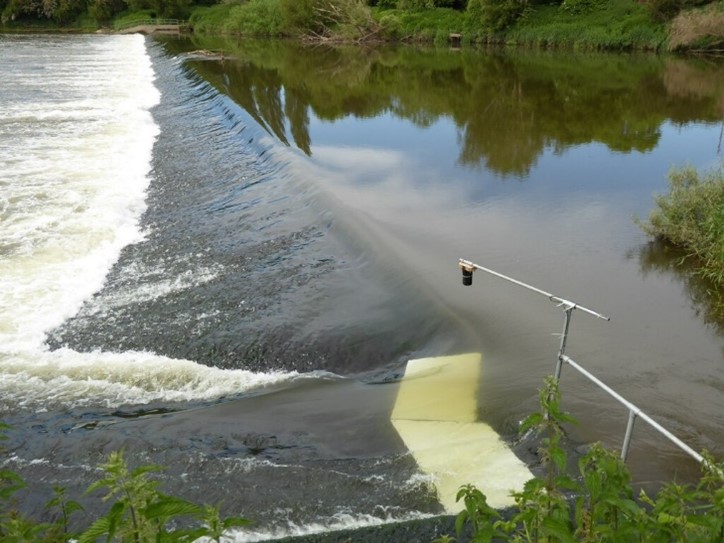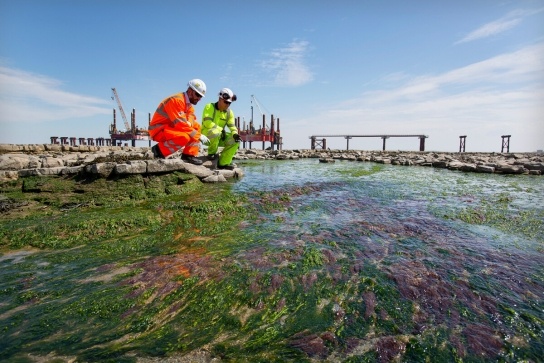Habitat Creation and Enhancement
Introduction
The creation of new habitat to help protect fish populations and benefit the wider environment replaces our proposal to install an acoustic fish deterrent system. The new habitats would compensate for potential impacts on protected fish species. The proposals include the creation of areas for saltmarsh, seagrass and kelp habitats, plus new native oyster beds and the removal of barriers in rivers for migrating fish in rivers.
The change provides a more natural, long-term solution that does not risk the lives of divers who would be needed to maintain an acoustic fish deterrent system.
As well as helping fish populations within the Severn Estuary, the new habitats will provide a wide range of additional benefits. They will support and grow local populations of birds, plant species, marine mammals, and reptiles. The plans will also help to improve water quality, act as natural flood defences, provide a sustainable carbon store and open access to nature for the local community and visitors.
New natural habitat is a better solution than a largely un-tested acoustic fish deterrent which would use 280 speakers to make noise louder than a jumbo jet 24-hours a day for 60 years. The system's impact on whales, porpoises and other species is unknown.
A Mix of Habitat Types
Our proposals include the creation of over 340 hectares of new saltmarsh, seagrass and kelp habitats, plus new native oyster beds and the removal of barriers in rivers to support the migration of fish to their breeding areas. The mix of habitat types act together to provide a significant and sustainable ecological benefit for Somerset and the Severn Estuary area as a whole.
The plans will be developed in partnership with a range of local experts including the Wildfowl and Wetlands Trust and the Somerset Wildlife Trust and provide long term benefits throughout Hinkley Point C’s operational lifetime and beyond.
1. Saltmarsh Creation and Enhancement
Saltmarsh is coastal grassland that is regularly flooded by seawater and we are proposing to create or enhance approximately 340 hectares of saltmarsh habitat in two locations along the River Parrett. Saltmarsh supports fish populations by providing breeding and feeding grounds whilst also helping to develop local populations of birds, plants, marine mammals, and reptiles. The benefits are long term and would extend well beyond the operational life of the new power station.
2. Creation or Enhancement of Native Oyster Beds
We are proposing to create or enhance around 1-2 hectares of native oyster beds. Suitable areas around the coast of the Severn Estuary will be assessed.
Native oyster beds were once common around the UK coastline, however 95% of them have now been lost. Oysters are an important species that support the wider ecosystem, including reef formation, erosion control, improvement of water quality, raw material supply and food provision.
3. Creation or enhancement of Native Seagrass Habitat
We are proposing to create or enhance around 5 hectares of seagrass habitat. Seagrass is a marine plant that grows in shallow waters. In addition to supporting a diverse ecosystem, seagrass meadows would also have numerous wider benefits including coastal protection and improved water quality.
4. Creation or enhancement of Kelp Forest
We are proposing to create or enhance around 15 hectares of Kelp Forest.
Kelp is a brown seaweed which can form dense submerged forests and is found across the UK.
Kelp is an important species that supports the wider ecosystem, aids coastal defence and plays a vital role in the maintenance of fish stocks. Kelp habitats are also important for a range of recreational activities, such as diving and angling.

The Benefits of Saltmarsh
Saltmarshes are high in natural biodiversity and important habitats for many different species including fish, invertebrates, birds, as well as unique salt-tolerant plant species. They play an important environmental role in our marine ecosystem as well as on land. Shellfish species such as oysters and mussels can also make use of this habitat, further enhancing local biodiversity.
In addition to the direct benefits to fish and other key species saltmarshes provide other valuable wider ecosystem services and benefits such as improved water quality, flood and coastal defence, recreation, food provision (through animal grazing and plant harvesting) and de-nitrification. They also act as an important carbon sink that will play an ever more important role in mitigating the effects of climate change. Saltmarshes in the UK are increasingly becoming lost and degraded in recent years due to a variety of pressures such as sea level rise and coastal development causing ‘coastal squeeze’. As a result, the creation and restoration of saltmarsh habitat is becoming increasingly important to improve overall ecosystem resilience and the ability of our environment to adapt to future environmental change.


Easement of Fish Migration Barriers
We are proposing the easement of existing barriers to fish migration upstream of the Severn Estuary. Weirs in rivers can create barriers to the movement and migration of fish and this can be harmful to local fish populations by limiting access to their spawning or feeding habitats. The restoration of natural river environments is seen as a vital consideration in the management of fish populations.
We have worked with organisations such as the Environment Agency, Natural England and Natural Resources Wales to identify existing weirs in rivers that are acting as barriers to fish migration.
We have identified a number of weirs that flow into the Severn Estuary where adaptations could help migratory fish, such as salmon and shad, swim upstream to spawn by up to 70%. Several methods could be used to ease the passage of fish. They include the complete removal of a weir, the partial removal of a weir or the installation of fish passes.
The changes could also benefit other fish species such as eels and lamprey. We are currently developing the design and engineering options for the weirs which could involve either fully or partially remove the weir itself or installing a dedicated fish pass.
We are proposing works on three weirs:
- Maisemore Weir on the River Severn
- Trostrey Weir on the River Usk
- One further weir on either the River Lugg (Mousenatch Weir, Eyton Weir, Coxall Weir), River Towy (Manorafon Weir) or River Severn (Upper Lode Weir)

Monitoring and Long Term Management
Our proposals for habitat restoration and creation will be long-term projects. As a result, we plan to also deliver a long-term adaptive monitoring and management plan that would continue to assess the positive impacts and success of the compensation package as a whole. Fish population numbers in particular are influenced by a huge range of natural factors so the the monitoring plan will be carefully designed to monitor and respond to the performance of the specific compensation measures that will be in place.
Further Information
Further information on the proposals can be found within the consultation overview document and supporting technical reports which are available on the consultation homepage.
Contact us
The best way to contact us about Hinkley Point C is by completing our online enquiry form. You can also call us on 0333 009 7070 (24 hour free phone number).
For EDF's 24/7 media enquiry line call 01452 652233.